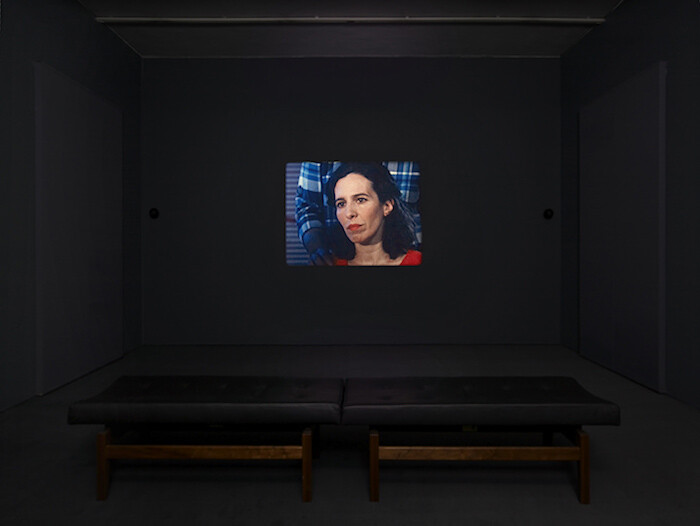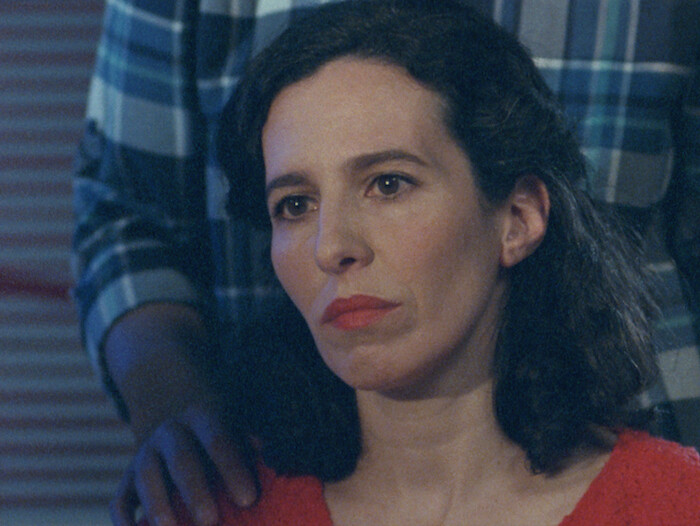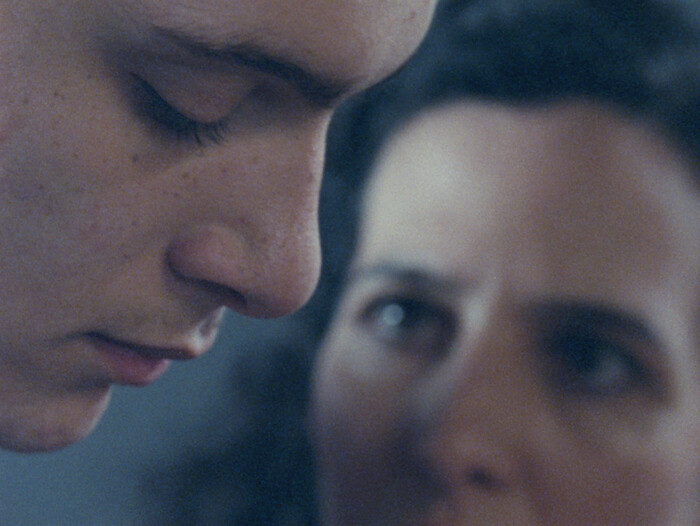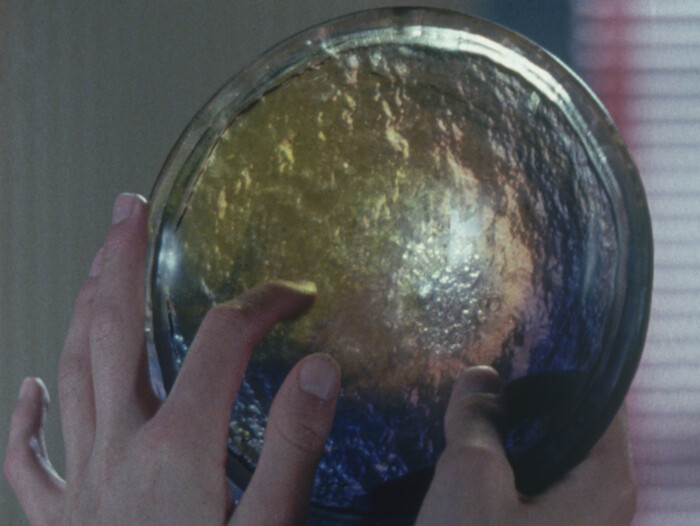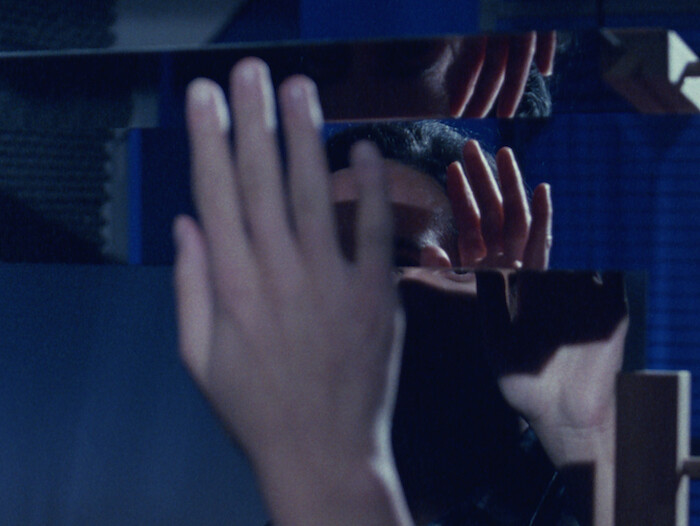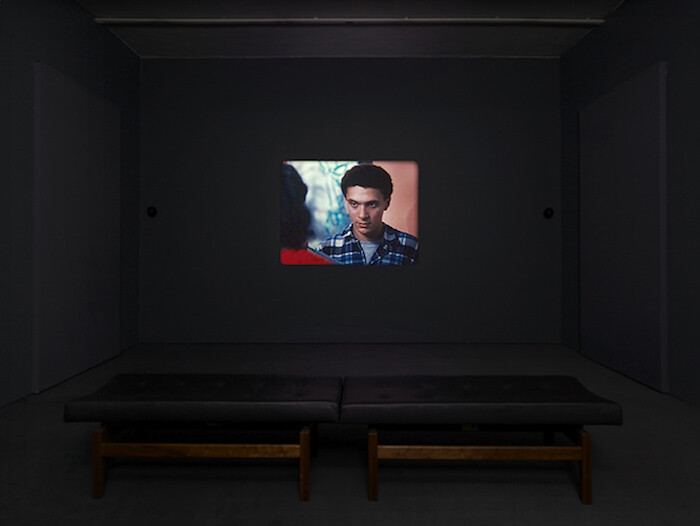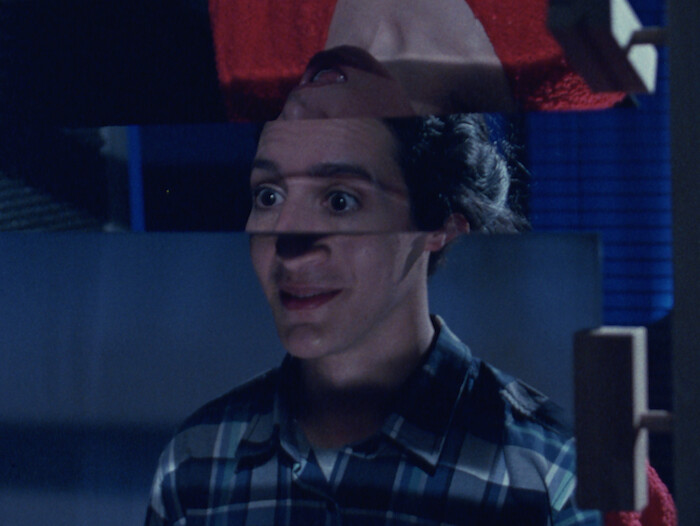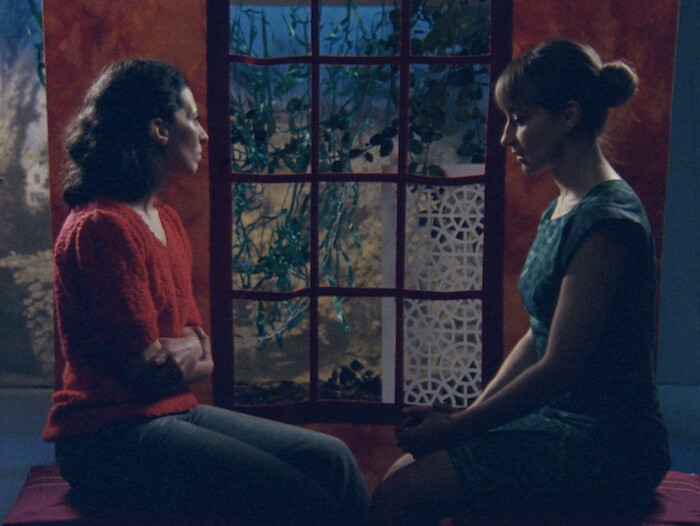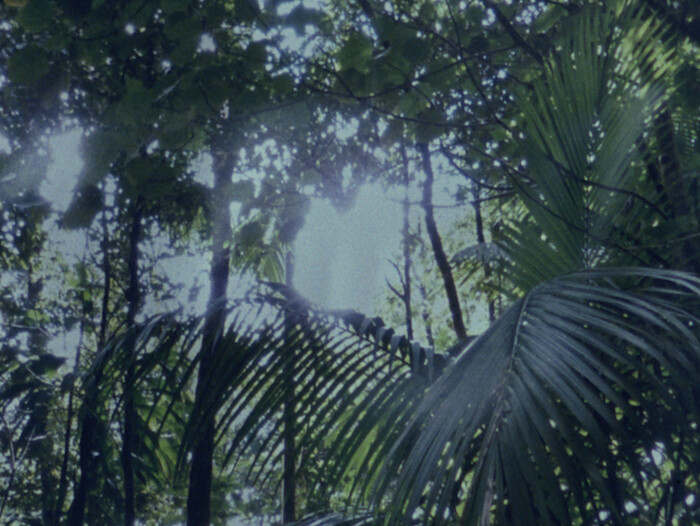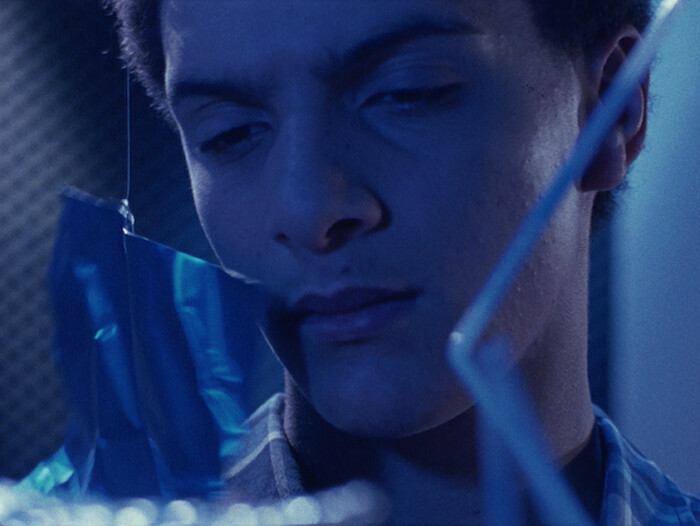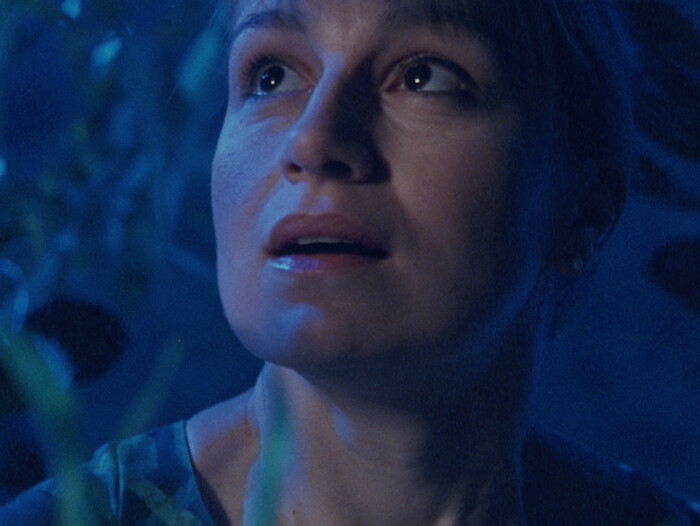“I experience pain and sensation in response to seeing or thinking about another individual getting hit or touched on part of their body.” This description of mirror-touch synesthesia—the ability to feel the same or sympathetic physiological sensations and emotional states in sync with another human being, animal, or sometimes an object—is given by Sophie. Her written account is part of a correspondence between London-based filmmaker Daria Martin and other mirror-touch synesthetes. All provide insights into experiences of highly empathic intersubjectivity, and informed Martin’s development of three short films. At The Threshold (2014-2015), a narrative of domestic co-dependency threatened by an outside force, is the second and most recent installment in the trilogy. Projected in a small, dark room, it is a…
Two images resonate after I leave Daria Martin’s exhibition at Maureen Paley. A pair of scissors spins on a ribbon, an idle motion until the camera pans down to reveal the palm upstretched to receive corkscrewing blades. There is also the plunge of a breakfast knife into a grapefruit, an innocent action invested by the camera’s focus with significant intent. These small but intense incisions—sharp-edged light between the slats of venetian blinds, patterned paper artfully ripped, a fork pushed through cake—deploy a careful violence across the dim luminescence of Daria Martin’s frames. They are part of how she conveys the sensitized intensities of shared pain between dislocated bodies, which is the condition of mirror-touch synesthesia, when a person experiences the sensate in another. As one of the protagonists in the film,…
“I experience pain and sensation in response to seeing or thinking about another individual getting hit or touched on part of their body.” This description of mirror-touch synesthesia—the ability to feel the same or sympathetic physiological sensations and emotional states in sync with another human being, animal, or sometimes an object—is given by Sophie. Her written account is part of a correspondence between London-based filmmaker Daria Martin and other mirror-touch synesthetes. All provide insights into experiences of highly empathic intersubjectivity, and informed Martin’s development of three short films. At The Threshold (2014-2015), a narrative of domestic co-dependency threatened by an outside force, is the second and most recent installment in the trilogy. Projected in a small, dark room, it is a hypnotic vision of uncanny sensuality, shot in saturated 16mm film, in which the lines between self, other, and object dissolve into a holistic sensory continuum.
The setup is simple. A mother and son are housebound synesthetes. Theirs is an interior world of wonder, a microcosm of things and materials that open a universe of rich associative and intensely poetic sensory experience. A red jumper, a cracked eggshell, a ball of wool: each cause a rush of psychophysiological associations for the reclusive pair when touched or seen. Wisely, Martin leaves space for the viewer to intuit these associations; we are not shown what it is that a thing is like. For example, there are no suggestive hard cuts from fingers running across the surface of some material to fingers running through grass. Instead we are able to forge empathic links by virtue of scenes in which the actors playing mother (Carolina Valdés) and son (Myles Westman) use a recognizable gestural vocabulary of awe and reverence in relation to things and each other. This is essentially how the reception of film works for viewers. An actor does something on screen we can empathize with, like laughing or crying, and then, if we’re able to suspend disbelief, we feel happy or sad, too. Psychoanalysts might describe this as a process of identification; neurologists might point to the existence of mirror neurons. Whatever the case for us, it is clear the boy and his mother feel a deep, borderline erotic connection, and this heightened sense of each other crucially extends to textures, hues, and inanimate materials—a sense that is eventually transferred and awakened in the viewer.
Into this dyadic relationship steps a third party, another woman bent on bringing the pair, or at least the boy, into the world. “I know the feeling of the leaves on the trees… I don’t need to go outside to feel that,” says the mother, who seems afraid that external stimuli will overwhelm her sense of self. Here, it’s possible to read At The Threshold as a kind of critical allegory, engaging with film theory’s discourse of passive spectatorship and disembodiment, albeit with one distinction: the boy’s mother seems to feel that exposure to life outside—rather than to the interior life of the cinema—will result in disembodiment and deindividuation. However, Martin’s interest in mirror-touch synesthesia goes far beyond the instrumentalization of a unique cognitive ability for creative, indirect critique. In fact, she has edited Mirror-Touch Synaesthesia: Thresholds of Empathy with Art, a book to be published by Oxford University Press in May this year. Let’s hope it touches on the potential social-cultural and political ramifications that mirror-touch synesthesia presents as a legitimate, and not abnormal, way of being. It is a territory with much scope.
The question mirror-touch synesthesia raises at this time of punitive government measures and harsh austerity is: what effects would a consciousness founded on empathy and a form of panpsychism have on a culture, society, and politics dominated by individualism, self-preservation, and competition? Indeed, the further reaches of holism and intersubjectivity covered by Martin’s project suggest many things: they foreground the state’s at times grotesque attitude of bureaucratic indifference to human suffering; problematize Graham Harman’s object-oriented ontology of a world of discrete, lonely, and inaccessible objects; and have some affinities with subatomic theories of quantum physics. These are linkages that require a leap, but Martin’s easy-to-digest narrative gives the viewer room to make wider associations. This is also due to her looser, more expressionistic, and absorbing direction in At The Threshold, a style that engenders a certain psychological drift, quite different from the austere air of contained detachment in Sensorium Tests (2012), part one of the trilogy, in which a mirror-touch test subject is put through her paces in a controlled lab experiment.
At The Threshold achieves that balance between information and its formal mediation, so difficult to reach in research-based practice. In other words, the resulting work isn’t the lesser interpretation of more fascinating research material. Rather, At The Threshold functions as a sensorial enchantment, a doorway that pulls the spectator into a world of porous psychophysiological boundaries. Through its impressive and compelling use of the essential empathic nature of viewing film, we are made to feel what is felt on screen. For the work’s duration, we are invited to become mirror-touch synesthetes too.
Two images resonate after I leave Daria Martin’s exhibition at Maureen Paley. A pair of scissors spins on a ribbon, an idle motion until the camera pans down to reveal the palm upstretched to receive corkscrewing blades. There is also the plunge of a breakfast knife into a grapefruit, an innocent action invested by the camera’s focus with significant intent. These small but intense incisions—sharp-edged light between the slats of venetian blinds, patterned paper artfully ripped, a fork pushed through cake—deploy a careful violence across the dim luminescence of Daria Martin’s frames. They are part of how she conveys the sensitized intensities of shared pain between dislocated bodies, which is the condition of mirror-touch synesthesia, when a person experiences the sensate in another. As one of the protagonists in the film, Myles, says to his mother, “everything you saw I saw too,” and this extends to sensations of touch and pain.
Martin has already been drawn to explore the condition of mirror-touch synesthesia in the first of a planned trilogy on the subject, Sensorium Tests, and while it takes a very different approach from its predecessor, At The Threshold deepens and builds upon Martin’s enquiry into a condition still little explored outside science. As images and framings hint throughout both films, Martin’s interest exceeds straightforward scientific curiosity, to find in mirror-touch synesthesia a compelling metaphor for the experience of cinema. Martin, of course, is not the first to explore the possibilities of an affective reciprocity between bodies onscreen and off. In his 1948 essay “Le Cinéma du Diable,” for example, Jean Epstein recognized the profundity of cinema’s synesthetic properties, writing of “knowledge gained directly through feelings, one that is immediate, practical, and supple—a kind of poetry that we acquire above all through what we see.”1 Cinema’s sensorial potential is played out in Martin’s tactile close ups on objects, surfaces, and costumes, imbuing them with the significant singularity that Epstein notes as the photogénie uniquely conferred upon things by the cinematic gaze: pregnant with undecipherable meanings and wayward energies.
I am also arrested by a further image in the opening scene of At The Threshold, when the camera zooms in on a scene depicting an exotic location of lush vegetation and blue skies. I remember an image similar to this in Sensorium Tests, except in that earlier film the palm trees and blue sky function, like the crumpled cutouts of waterfalls and beaches familiar from the ceilings of dentist’s surgeries or hospital operating rooms, to calm nervous patients undergoing the first tests into this little known condition. But the blue skies and palm trees in At The Threshold’s opening scene are designed as a plane of projection for the viewer rather than that of the anxious patient, functioning as a threshold into the drama of the film about to unfold. At The Threshold is distinctive from Martin’s earlier works for its more explicit concentration on the dialogue, characterization, and plot development used by cinematic fictions, as it relays the story of an intense relationship between mother, son, and stepmother. The story enables Martin to introduce a new dimension to her study of mirror-touch synesthesia, asserting in the complex symbiosis of fictional mother and son the “queer place” of the mother-infant bond described by D. W. Winnicott, “where nothing has yet been separated out as not-me.”2 Martin posits this familial symbiosis as an equivalent to the profound connection that a synesthete might have when they experience another’s sensations.
The palm tree image acts as a hinge between these first two films of Martin’s trilogy, showing two different faces of synesthesia: the first represented through the objective register of scientific re-enactment, and the second drawing out in cinematic drama the research Martin has undertaken into the real-life intensities of the synesthete’s experience. The heightened attention to tactile surface detail, suggestive lighting, and musical accompaniment characteristic of earlier works such as Harpstrings and Lava (2007) here effectively renders the emotional tone of the narrative in a higher key, revealing latent associations to cinema’s melodramatic traditions in Martin’s work which have been there all along. One might trace Douglas Sirk or Rainer Werner Fassbinder in the lush metaphors of her set pieces, but I find in At The Threshold a telenovela intimacy. Like those deft low-budget productions, Martin orchestrates and amplifies emotional range through the abbreviations of lingering close up, stripped-back sets, and washes of colored light, exerting the uncanny of familial bond and sensate connection through the telenovela’s heightened artificialities. In a memorable closing scene, this “queer place” of porous identities encounters an instance of photogénie, when the set asserts independent agency, and freestanding screens glide around the stationary stepmother, in a dance of revelation and concealment which speaks beyond the emotional vulnerabilities of Martin’s protagonist to a wider human condition, and in particular those of a sensitized affective nature, who feel as others do.
3 Jean Epstein, “Le Cinéma du diable,” in Jean Epstein: Critical Essays and New Translations, ed. Sarah Keller and Jason N. Paul (Amsterdam: Amsterdam Univer-sity Press, 2012), 326.
Excerpts of Daria Martin’s written correspondences with mirror-touch synesthetes can be viewed at the artist’s website: http://dariamartin.com/#texts
D. W. Winnicott, The Family and Individual Development (London: Routledge, 1965/2006), 25.
Excerpts of Daria Martin’s written correspondences with mirror-touch synesthetes can be viewed at the artist’s website: http://dariamartin.com/#texts
